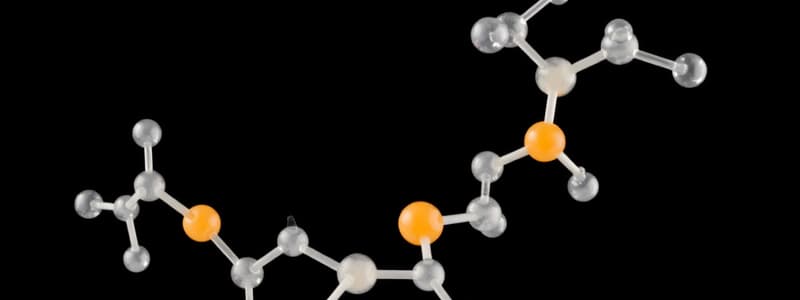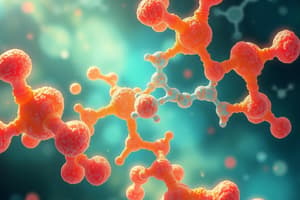Podcast
Questions and Answers
Which of the following polysaccharides acts as a plant food reserve?
Which of the following polysaccharides acts as a plant food reserve?
Branch points in starch and glycogen are due to formation of ______ glycosidic bonds between glucose residues.
Branch points in starch and glycogen are due to formation of ______ glycosidic bonds between glucose residues.
α(1→6)
In amylopectin, branching is observed at the interval of every ______ glucose residues.
In amylopectin, branching is observed at the interval of every ______ glucose residues.
Which of the following disaccharides is obtained by digestion of amylose by the enzyme amylase?
Which of the following disaccharides is obtained by digestion of amylose by the enzyme amylase?
Signup and view all the answers
Which of the following polysaccharides is found in plant fibers?
Which of the following polysaccharides is found in plant fibers?
Signup and view all the answers
Which of the following mucopolysaccharides is not sulfated?
Which of the following mucopolysaccharides is not sulfated?
Signup and view all the answers
Which of the following does not have nutritional value?
Which of the following does not have nutritional value?
Signup and view all the answers
Match the following:
Match the following:
Signup and view all the answers
Flashcards
Carbohydrates
Carbohydrates
Biopolymers composed of monosaccharide units, essential for life.
Monosaccharides
Monosaccharides
Simple sugars that cannot be hydrolyzed further; examples include glucose.
Oligosaccharides
Oligosaccharides
Carbohydrates made of 2-10 monosaccharide units linked together.
Polysaccharides
Polysaccharides
Signup and view all the flashcards
Glycogen
Glycogen
Signup and view all the flashcards
Starch
Starch
Signup and view all the flashcards
Amylose
Amylose
Signup and view all the flashcards
Amylopectin
Amylopectin
Signup and view all the flashcards
Cellulose
Cellulose
Signup and view all the flashcards
Chitin
Chitin
Signup and view all the flashcards
Glycosaminoglycans (GAGs)
Glycosaminoglycans (GAGs)
Signup and view all the flashcards
Hyaluronic acid
Hyaluronic acid
Signup and view all the flashcards
Proteoglycans
Proteoglycans
Signup and view all the flashcards
Glycoproteins
Glycoproteins
Signup and view all the flashcards
N-linked glycoproteins
N-linked glycoproteins
Signup and view all the flashcards
O-linked glycoproteins
O-linked glycoproteins
Signup and view all the flashcards
Homopolysaccharides
Homopolysaccharides
Signup and view all the flashcards
Heteropolysaccharides
Heteropolysaccharides
Signup and view all the flashcards
Glycosidic bonds
Glycosidic bonds
Signup and view all the flashcards
Mucopolysaccharidoses
Mucopolysaccharidoses
Signup and view all the flashcards
Glycolipids
Glycolipids
Signup and view all the flashcards
Cell signaling
Cell signaling
Signup and view all the flashcards
Blood types
Blood types
Signup and view all the flashcards
Glycosylation
Glycosylation
Signup and view all the flashcards
Clinical significance of GAGs
Clinical significance of GAGs
Signup and view all the flashcards
GAGs in diseases
GAGs in diseases
Signup and view all the flashcards
Reproductive functions of glycoproteins
Reproductive functions of glycoproteins
Signup and view all the flashcards
Enzyme replacement therapy (ERT)
Enzyme replacement therapy (ERT)
Signup and view all the flashcards
Mucoproteins
Mucoproteins
Signup and view all the flashcards
Chondroitin sulfate
Chondroitin sulfate
Signup and view all the flashcards
Study Notes
Carbohydrates Chemistry
- Carbohydrates are organic molecules composed of carbon, hydrogen, and oxygen.
- They are polymers, meaning they are large molecules made up of simple units (monomers) repeated many times.
- The most common monomer is glucose.
- Carbohydrates are classified into monosaccharides, oligosaccharides, and polysaccharides based on the number of monosaccharide units.
- Monosaccharides are the simplest units that cannot be further hydrolyzed.
- Oligosaccharides contain 2–10 monosaccharide units.
- Polysaccharides contain 10–100 or more monosaccharide units/residues, linked by glycosidic bonds.
- Polysaccharides are also known as glycans.
Polysaccharides
- Polysaccharides are complex carbohydrates with multiple monosaccharides bonded together.
- They are often insoluble in water, amorphous, and non-sweet.
- Common examples include starch, cellulose, glycogen, and chitin.
- Starch: Plant storage form of glucose
- Cellulose: Structural component of plant cell walls.
- Glycogen: Animal storage form of glucose.
- Chitin: Forms the exoskeletons of some animals and the cell walls of fungi.
Classification of Polysaccharides
- Homopolysaccharides: Composed of the same type of monosaccharide.
- Heteropolysaccharides: Composed of different types of monosaccharides.
Starch
- Starch is a polymer of α-glucose.
- It is a mixture of amylose and amylopectin.
- Amylose: Linear, unbranched chain.
- Amylopectin: Branched chain.
- Both are storage forms of glucose in plants.
Glycogen
- Glycogen is an animal storage form of glucose.
- Structurally similar to amylopectin but more branched.
- It's stored mainly in the liver and muscles.
- Glycogenolysis is the breakdown of glycogen into glucose when energy is needed.
Cellulose
- Cellulose is a structural polysaccharide found in plant cell walls.
- It's composed of linear unbranched chains of glucose.
- The glycosidic linkages give it a strong and rigid structure.
Chitin
- Chitin is a structural polysaccharide found in the exoskeletons of insects and crustaceans.
- It's also a component of fungal cell walls.
- Composed of N-acetyl-β-D-glucosamine.
Glycosaminoglycans (GAGs)
- GAGs are long unbranched polysaccharides, also called mucopolysaccharides.
- Composed of repeating disaccharide units, containing uronic acids and amino sugars.
- They are essential components of connective tissues, such as cartilage, tendons, and skin.
- Hyaluronic acid, chondroitin sulfate, dermatan sulfate, heparin sulfate, and keratan sulfate are examples of GAGs.
Glycoproteins
- Glycoproteins are proteins with carbohydrate chains attached (glycosylation).
- Involved in various cellular processes, including cell-cell recognition, immune responses, and hormone transport.
- The carbohydrate portion (glycan) can vary widely in structure and composition.
- There are many applications and functions of glycoproteins.
Studying That Suits You
Use AI to generate personalized quizzes and flashcards to suit your learning preferences.
Related Documents
Description
Test your knowledge on carbohydrates, including their structure, classification, and examples of polysaccharides. This quiz covers key concepts such as monosaccharides, oligosaccharides, and polysaccharides, and their roles in biology. Perfect for students studying organic chemistry or biochemistry.




